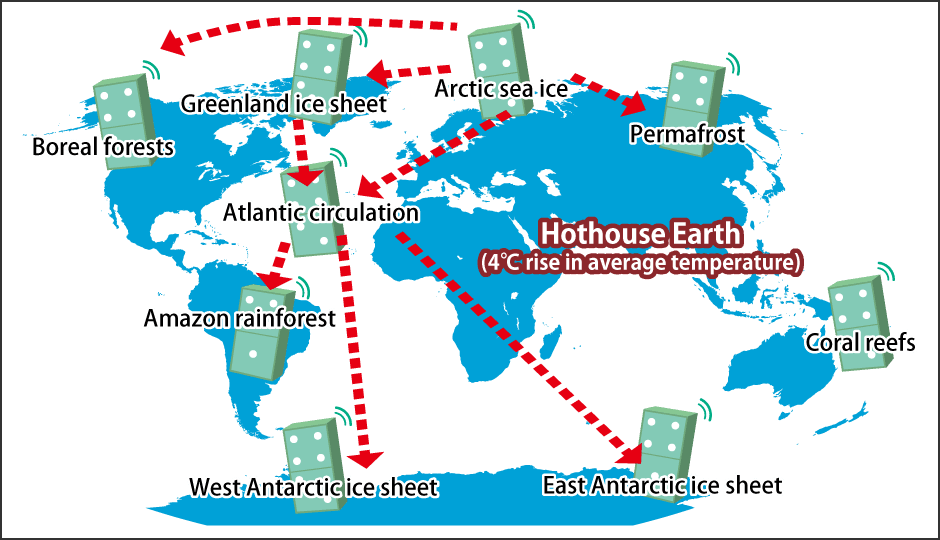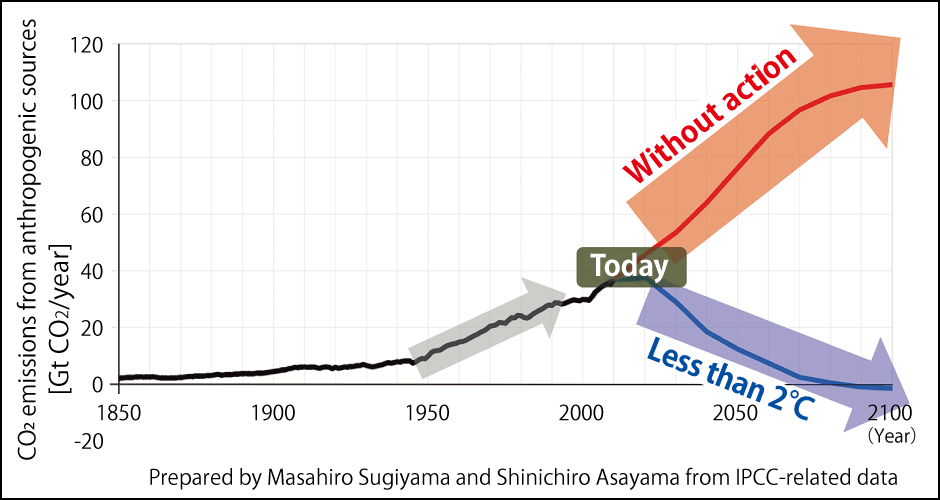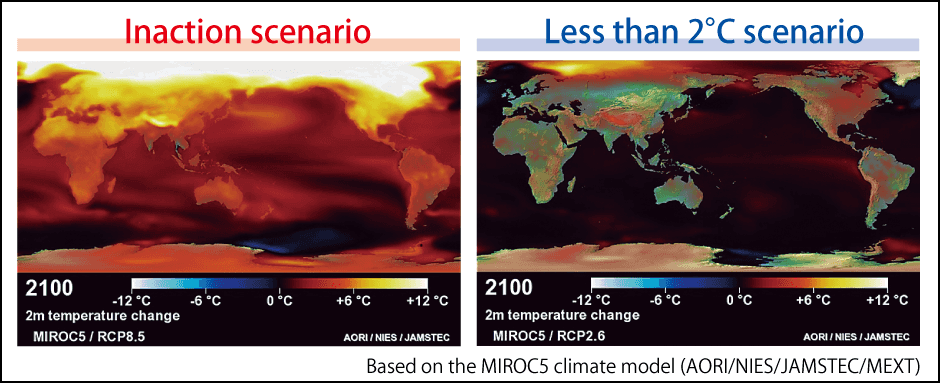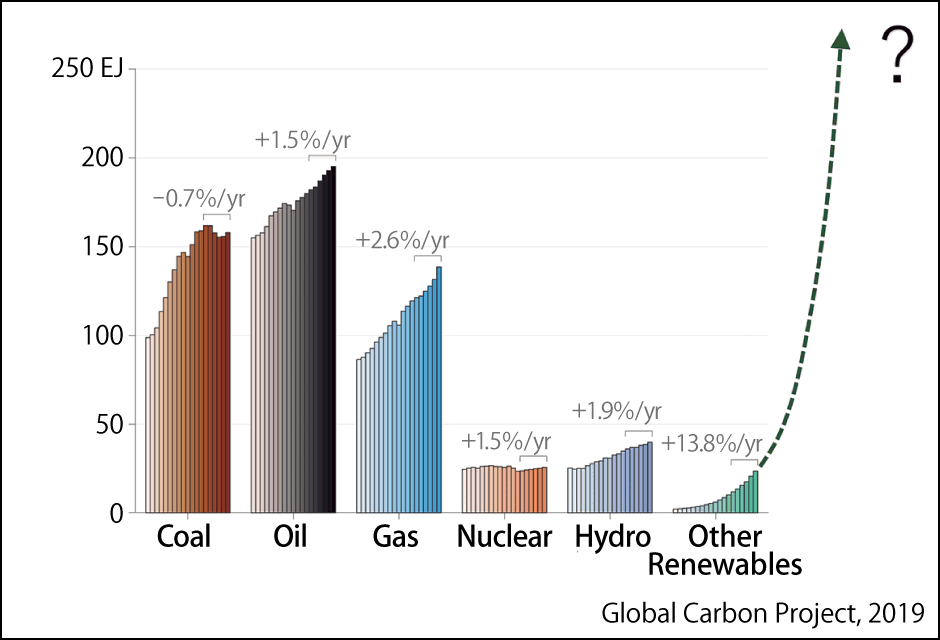Countries worldwide are stepping up efforts to reduce emissions of carbon dioxide (CO2) and other greenhouse gases (GHGs). Japan has decided on a target of reducing GHG emissions by 46% from FY2013 levels by FY2030. However, achieving this massive target will require a great many challenges to be overcome, and it will be extremely difficult to do so within a socioeconomic structure bound by the conventions that have held sway until now. Not only technological innovation, but also a drastic transformation in the very fabric of society will be needed.
Special Feature 1 – The Zero Carbon Reality Achieving a 46% cut in emissions: structural change can no longer be delayed
composition by Rie Iizuka
illustration by Koji Kominato
Moves to create an international framework on climate change date back to 1992. The United Nations (UN) adopted the United Nations Framework Convention on Climate Change (UNFCCC) for the purpose of stabilizing concentrations of GHGs in the atmosphere, and the international community agreed to work on measures to combat global warming. From 1995, the Conference of the Parties (COP) to the UNFCCC was held annually, and the Paris Agreement was adopted as a new international framework from 2020 at COP 21 in 2015.
In the Paris Agreement, the parties agreed to hold the increase in the global average temperature to well below 2°C, preferably to 1.5°C, compared to pre-industrial levels.
There are two key figures here: 2°C and 1.5°C. COP 15 in 2009 saw a split emerge between developed countries, which sought to limit the rise in the global average temperature to 2°C, and developing countries, which regarded the target as too high and argued that the parties should aim for 1.5°C. As there was not enough scientific understanding of the significance of those two figures at that point, the Intergovernmental Panel on Climate Change (IPCC), which conducts scientific assessments of climate change, undertook several assessments and, in 2018, published the special report Global Warming of 1.5°C.
Several hundred million more people will be impacted by a rise of 2°C
The report projects that tropical coral reefs will decline by a further 70 — 90% at 1.5°C and by more than 99% at 2°C, and that the Arctic Ocean will become entirely ice–free during summer once per decade if global warming exceeds 2°C. It also contains the striking statement that “limiting global warming to 1.5°C, compared with 2°C, could reduce the number of people both exposed to climate-related risks and susceptible to poverty by up to several hundred million.”
Furthermore, the report states “in model pathways with no or limited overshoot of 1.5°C, global net anthropogenic CO2 emissions decline by about 45% from 2010 levels by 2030, reaching net zero around 2050.”
The figures in the Paris Agreement use as their baseline the temperature in the period before the Industrial Revolution, which saw a sharp rise in emissions of the GHGs —— CO2 in particular —— that cause global warming. As global warming has already reached 1°C above that baseline, we are actually trying to keep the rise to somewhere in the range between 0.5°C and 1°C.
Now let us look at what a rise in global average temperatures will mean in slightly more specific terms.
First of all, the melting of ice in Antarctica, Greenland, and mountain glaciers will cause sea levels to rise. Rising temperatures will also result in the thermal expansion of seawater. Sea levels have already risen by an average of 20 cm.
In addition, powerful typhoons will become more common, resulting in more frequent flooding. In Japan, we have already seen the reality with an increase in extreme weather conditions, including the 2018 West Japan floods, the subsequent period of scorching summer heat, and the record damage caused by Typhoons Faxai and Hagibis in 2019. Combined with the heat island effect in cities, the increase in heat waves is also likely to bring about a rise in the number of fatalities from heatstroke.
Furthermore, forecasts suggest that impacts on agricultural crops will cause food shortages, while global warming in the arid regions of the world will trigger more frequent droughts, resulting in water shortages.
Marine and land ecosystems alike will also be affected. Another problem is ocean acidification, caused by the sea absorbing CO2 from the atmosphere as temperatures rise.
Risk of a 4°C rise in average temperature
COVID-19 is a pandemic that will go down in history, but we must not lose sight of the fact that infectious diseases transmitted by mosquitoes and other vectors will spread more easily if global warming progresses.
A 2018 paper on the topic of “Hothouse Earth” shocked the world with its forecasts for the impact of global warming.
The paper states that there are temperature tipping points for regions playing an important role in global warming, such as the Amazon rainforest and the Greenland ice sheet. It posits that once one of these points is reached, rapid, irreversible change will occur, which will affect the tipping points of other locations, triggering a domino-like cascade and causing a rise of up to 4°C or so in the average temperature (Figure 1).

Figure 1. Tipping elements and their cascades (domino effects)Climate change will occur in a cascade, starting at places that have reached their tipping point. Thus, when global warming results in a reduction in the volume of CO2 absorbed by the Amazon rainforest, due to deforestation, or melting of Arctic permafrost or Antarctic ice causes the release into the atmosphere of methane gas, which has an even greater warming effect than CO2, global warming will be accelerated, and other systems will be triggered, too. The paper stated that this cascade could occur with a rise of 2°C in the average temperature, providing scientific backing for the view expressed by the IPCC in its Global Warming of 1.5°C report, that 2°C is too high.
These results prompted several rounds of discussion by the international community, which agreed to stem the tide of global warming and set the figure of 1.5°C as the target.
Curbing CO2 emissions is essential to keep the rise in average temperature to between 1.5°C and 2°C. In the Paris Agreement, the parties aimed to “achieve a balance between anthropogenic emissions by sources and removals by sinks of greenhouse gases in the second half of this century.” (Figure 2)

Figure 2. Anthropogenic GHG emissions and the curbing of global warming through their reductionTo keep the rise in temperature below 1.5°C, we will need to curb GHG emissions by around 2050, while to keep it below 2°C, we will need to do so by around 2070. In addition, we will need to reach net-zero CO2 emissions from human activity worldwide by increasing absorption capabilities through the prevention of deforestation and increases in forest area.
In partnership with the University of Tokyo and the Japan Agency for Marine-Earth Science and Technology (JAMSTEC), we at NIES have developed the Model for Interdisciplinary Research on Climate (MIROC), which we use for simulations of climate change from the past right through to the future.

Figure 3. Simulations of climate change in 2100Over several decades, differences in the volume of CO2 emissions will add up to very different situations.
Figure 3 shows simulations of global temperatures in 2100 based on a scenario in which the world curbs CO2 emissions and keeps the average temperature rise below 2°C, and another in which we take no steps to combat climate change and emissions continue to grow. In both simulations, the temperature around the Arctic Ocean initially continues to rise, but the extent of the temperature rise begins to differ in 2060 or thereabouts. In the scenario in which no action is taken, the global average temperature has risen by around 4°C by 2100, resulting in increased temperatures on land in the northern hemisphere, with areas near the North Pole seeing a rise of 6—10°C. On the other hand, if CO2 emissions are curbed sufficiently, the results show the rise in average temperature halting in around 2050.
Breaking free from fossil fuels is fundamental to achieving net-zero CO2 emissions. At present, around 80% of the world’s energy is produced from fossil fuels, but we will ultimately need to switch to using renewable energy in the form of solar power, hydropower, and wind power to meet almost all of our energy requirements.
According to a report by the International Energy Agency (IEA), 90% of new power supply facilities built across the globe in 2020 used renewable energy, taking the renewable power generation capacity to a record 198 GW. This is because power generation using renewable energy is cheaper worldwide. Even without thinking about cutting CO2, economic considerations are driving the development of systems encouraging players to choose renewable energy and the transition to renewable energy is underway (Figure 4).

Figure 4. Annual global energy consumption, 2000-2018While fossil fuel consumption is, unfortunately, still on the rise, increases in power generation using renewable energy are also gathering pace. The figures in the graph show the annual growth rates from 2013 to 2018.
Naturally, some industries based on fossil fuels have existing facilities and other assets, giving rise to questions about how easily they can switch to renewable energy. Moreover, there are issues around the mining of scarce resources used in renewable energy equipment and electric vehicles, namely cobalt and lithium. We will likely need to overcome a number of challenges to make renewable energy a major energy source that we can generate stably and in large quantities.
Targets impossible to achieve with the current mindset
Some have criticized renewable energy as actually being responsible for environmental destruction. It is true that no appropriate system of environmental impact assessment has been put in place for solar photovoltaic power generation projects, and there have been cases in which, for example, forests were felled so that land could be covered with solar panels. However, this is an institutional design problem, and efforts to resolve such issues should be undertaken going forward while we pursue appropriate increases in renewable energy.
The attempt to confine the rise in average temperature to 1.5°C if possible and 2°C at worst is a massive undertaking. Doubtless, some people will wonder whether it is really possible. I would like to tell them that it is possible, but not with the current mindset.
Japan and other countries recently raised their CO2 reduction targets for 2030. One wonders what impact these figures will have on global warming. An evaluation by the NGO named Climate Action Tracker suggests that if every country around the world were to achieve all the targets they have set, the rise in temperature would be kept to around 2.4°C. So that 2°C figure is starting to come into sight.
It is estimated that CO2 emissions will need to be reduced to zero by 2070 if the temperature rise is to be kept to 2°C and by 2050 in the case of 1.5°C. However, these figures are based on the assumption that every country in the world —— developed and developing countries alike —— implements the necessary measures. While China has committed to reaching net-zero CO2 emissions by 2060, India and other countries still in the midst of economic growth are likely to be the source of rising emissions for some time to come. In this sense, developed countries need to take the lead in reducing emissions.
Essential to achieving these numerical targets will be what is called Green Growth. In contrast to conventional economic growth, which basically polluted the environment, this concept focuses on creating a zero-carbon society by achieving both environmental protection and economic growth now that renewable energy has become cheaper. Japan is among the countries progressing in this direction, but is it really the appropriate approach to take?
Even if we do switch to renewable energy, the transition will not be able to keep pace with rising energy use if consumption is allowed to continue growing unchecked, which will make it impossible to reduce CO2 emissions. As such, some are beginning to take the view that we should rethink our approach to consumption and to the structure of our economy and society. For example, in our current economic system, airlines provide frequent flyer incentives for air travel, which encourages consumption, but some people believe we should switch to a structure in which the expectation is that those who fly more pay more in tax, thereby limiting consumption.
The ability to transform socioeconomic structures holds the key
Even when economic activities ground to a halt across the globe because of the COVID-19 pandemic last year, CO2 emissions fell by just 7%. While we might feel we did not do anything, the fact is that a large amount of CO2 emissions is generated even under those circumstances. Curbing CO2 emissions within existing social systems is tricky, and it would be fair to say that our ability to transform socioeconomic structures holds the key to whether we can limit the temperature rise to 1.5°C.
I believe that what each and every one of us can do to contribute is to use our imagination.
Climate justice has become a focus when talking about climate issues. It would be fair to say that the current state of climate change is the result of developed countries having emitted a large volume of CO2. Developed countries enjoyed the benefits of this, but when we look at who is affected by global warming, first and foremost, we can see that it is people in developing countries and others in vulnerable positions.
Despite holding hardly any responsibility for the situation, they are suddenly having to pay the price of global warming, in the form of their countries being submerged in the sea or the loss of their jobs or houses being destroyed by major disasters. This seems extremely unfair and unethical. The awareness that we need to rectify this structure has spread worldwide. Now is the time for us to put ourselves in the place of those confronted by what is happening in developing countries. Doing so ought to make us alter our day-to-day choices about such matters as whether to buy a hybrid or an electric vehicle, for example, or even whether to forgo car ownership completely. Efforts to conserve energy are, of course, important, but if they are underpinned by imagination, I believe we will start to transform social systems.




















